-
ARTÍCULO ORIGINAL06/10/2023
Perception of graduates about the education of Nursing Technicians
Revista Brasileira de Enfermagem. 2023;76(5):e20220325
Resumen
ARTÍCULO ORIGINALPerception of graduates about the education of Nursing Technicians
Revista Brasileira de Enfermagem. 2023;76(5):e20220325
DOI 10.1590/0034-7167-2022-0325
Visualizações0Ver maisABSTRACT
Objectives:
to interpret the perception of graduates from the nursing technician program on the learning process developed during their education.
Methods:
a qualitative study was conducted from March to September 2021, based on interviews with 20 graduates from a nursing technician program at a school in the Midwest of São Paulo, using thematic analysis and the NVivo tool.
Results:
the following themes were identified: traditional teaching methods, active learning strategies, valuing proactivity and experiences in professional practice.
Final Considerations:
according to the graduates, the teaching process is essentially based on traditional methods, although there are initiatives to implement active strategies and recognition of the importance of advancing student proactivity and practical experience.
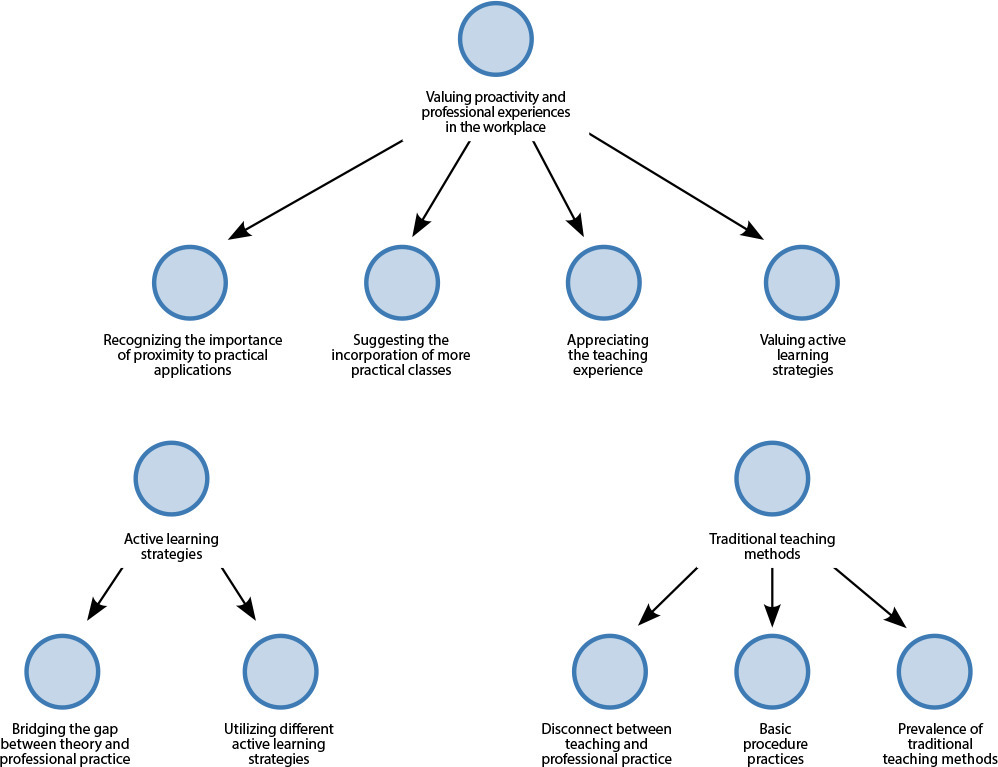
-
ARTÍCULO ORIGINAL06/10/2023
Nursing, history, and orthopedics in manuals (1875-1928)
Revista Brasileira de Enfermagem. 2023;76(5):e20220567
Resumen
ARTÍCULO ORIGINALNursing, history, and orthopedics in manuals (1875-1928)
Revista Brasileira de Enfermagem. 2023;76(5):e20220567
DOI 10.1590/0034-7167-2022-0567
Visualizações0Ver maisABSTRACT
Objectives:
to discuss the content of manuals, with emphasis on orthopedics, in support of the development of nursing care culture.
Methods:
cultural-historical method articulated with document analysis technique. The sources were nursing manuals – Portuguese, French, English, and Spanish – from 1875 to 1928.
Results:
this study pointed to 12 works – 6 authored by physicians, 2 by nurses, 3 institutional, and 1 by a Sister of Charity – that presented, in a transversal way, the professionalization process initiated in Europe. The manuals addressed first aid care and immobilization methods, from the simplest, such as improvised splints, to the application of plaster casts.
Conclusions:
the nurses’ work, even in a limited capacity, showed that they were able to observe warning signs so that doctors could act, with some exceptions.

-
06/10/2023
Evidências do cuidado centrado no paciente no contexto da prática profissional de saúde brasileira
Revista Brasileira de Enfermagem. 2023;76(5):e20220448
Resumen
Evidências do cuidado centrado no paciente no contexto da prática profissional de saúde brasileira
Revista Brasileira de Enfermagem. 2023;76(5):e20220448
DOI 10.1590/0034-7167-2022-0448
Visualizações0Ver maisRESUMEN
Objetivos:
analizar las actitudes centradas en el paciente en el cuidado y compartir prácticas de profesionales de enfermería, logopedia, odontología y medicina.
Métodos:
se utilizó una investigación transversal con 411 profesionales, y como medida de resultado se aplicó el instrumento Patient-Practitioner Orientation Scale.
Resultados:
los médicos presentaron puntuaciones medias más altas, lo que refleja una orientación centrada en el paciente, control compartido y enfoque en la persona, con diferencia estadística para todos los dominios (p<0,02). Los odontólogos fueron los profesionales que presentaron puntajes más bajos, especialmente en el dominio compartir, con diferencia estadística en relación a los enfermeros, logopedas y médicos (p<0,05).
Conclusiones:
finalmente, las actitudes de los profesionales de las áreas de salud estudiadas indicaron preferencia autorreferida por la centralidad en los pacientes. En este contexto, el cuidado centrado en el paciente puede ser un recurso importante en el cuidado de la salud cuando se apuesta por la superación del objeto hombre.
-
ARTÍCULO ORIGINAL06/10/2023
Learning strategies of undergraduate nursing students during the COVID-19 pandemic
Revista Brasileira de Enfermagem. 2023;76(5):e20220764
Resumen
ARTÍCULO ORIGINALLearning strategies of undergraduate nursing students during the COVID-19 pandemic
Revista Brasileira de Enfermagem. 2023;76(5):e20220764
DOI 10.1590/0034-7167-2022-0764
Visualizações0Ver maisABSTRACT
Objectives:
to analyze the learning strategies used by nursing students from a public university, in remote teaching, during the COVID-19 pandemic.
Methods:
a cross-sectional study developed with nursing students who attended remote teaching classes. The sample was obtained by convenience and data were collected online, with 112 participants. Student and Mann-Whitney tests were performed for data analysis.
Results:
the most frequently used learning strategies were self-regulatory and cognitive. There was moderate use of interpersonal help-seeking and emotional control strategies. Male students, with a private study environment and good internet connection, used emotional control strategies more frequently.
Conclusions:
self-regulatory and cognitive learning strategies, appropriate for higher education, were frequently used by nursing students, which is an important tool for adapting these students to the university context.
-
ARTÍCULO ORIGINAL06/10/2023
Evidencias del cuidado centrado en el paciente en el contexto de la práctica profesional de la salud brasileña
Revista Brasileira de Enfermagem. 2023;76(5):e20220448
Resumen
ARTÍCULO ORIGINALEvidencias del cuidado centrado en el paciente en el contexto de la práctica profesional de la salud brasileña
Revista Brasileira de Enfermagem. 2023;76(5):e20220448
DOI 10.1590/0034-7167-2022-0448
Visualizações0RESUMEN
Objetivos:
analizar las actitudes centradas en el paciente en el cuidado y compartir prácticas de profesionales de enfermería, logopedia, odontología y medicina.
Métodos:
se utilizó una investigación transversal con 411 profesionales, y como medida de resultado se aplicó el instrumento Patient-Practitioner Orientation Scale.
Resultados:
los médicos presentaron puntuaciones medias más altas, lo que refleja una orientación centrada en el paciente, control compartido y enfoque en la persona, con diferencia estadística para todos los dominios (p<0,02). Los odontólogos fueron los profesionales que presentaron puntajes más bajos, especialmente en el dominio compartir, con diferencia estadística en relación a los enfermeros, logopedas y médicos (p<0,05).
Conclusiones:
finalmente, las actitudes de los profesionales de las áreas de salud estudiadas indicaron preferencia autorreferida por la centralidad en los pacientes. En este contexto, el cuidado centrado en el paciente puede ser un recurso importante en el cuidado de la salud cuando se apuesta por la superación del objeto hombre.
Palavras-chave: Atención Centrada en la PersonaAtención Dirigida al PacientePersonal de SaludPráctica ProfesionalProfesionales de la SaludVer mais -
06/10/2023
Advanced Practice Nursing: “Training” Pillar in Supporting the Proposal in Brazil
Revista Brasileira de Enfermagem. 2023;76(5):e20230118
Resumen
Advanced Practice Nursing: “Training” Pillar in Supporting the Proposal in Brazil
Revista Brasileira de Enfermagem. 2023;76(5):e20230118
DOI 10.1590/0034-7167-2023-0118
Visualizações0Ver maisABSTRACT
Objectives:
to present the pillars that support what has been called Advanced Practice Nursing and discuss the necessary training for its implementation.
Methods:
elements contained in assessment documents for graduate programs proposals, reports of presentations by international professors in countries and selected scientific publications were gathered to compose the argument.
Results:
practice/competency (adds broad and in-depth knowledge about health processes and scientific evidence, clinical reasoning and clinical skills for therapeutic indications); 3) professional regulation (corresponding legislation and monitoring); and 4) funding (broad training and professional practice policy).
Final Considerations:
the agenda for implementing Advanced Practice Nursing in Brazil involves joining efforts to identify stakeholders for a work to legitimize their importance in the country’s health and education overview.
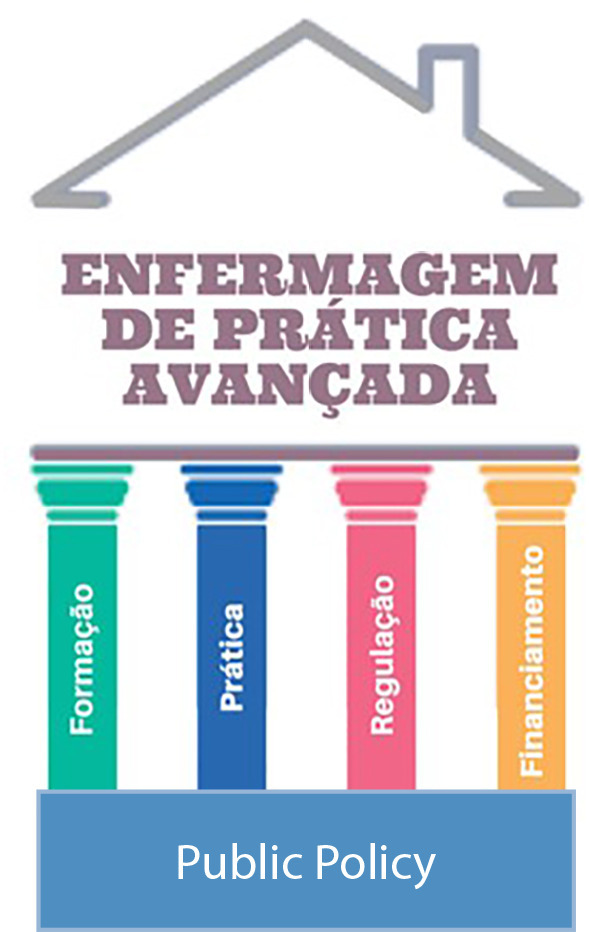
-
ARTÍCULO DE REVISIÓN06/10/2023
Nursing theories in the care of stroke patients: a scoping review
Revista Brasileira de Enfermagem. 2023;76(5):e20220791
Resumen
ARTÍCULO DE REVISIÓNNursing theories in the care of stroke patients: a scoping review
Revista Brasileira de Enfermagem. 2023;76(5):e20220791
DOI 10.1590/0034-7167-2022-0791
Visualizações0Ver maisABSTRACT
Objectives:
to map and synthesize nursing theories and conceptual frameworks that have been applied in the practice of nursing care for stroke patients in hospital settings.
Methods:
a scoping review was conducted in October 2022 using the MEDLINE (accessed via PubMed), CINAHL, Scielo, and Web of Science databases, following The Joanna Briggs Institute guidelines.
Results:
nine studies incorporated six nursing theories and three conceptual frameworks, which were employed to enhance stroke patient care. The objective of these theories and conceptual frameworks was to facilitate the identification of the patient’s psychobiological, psychosocial, and psychospiritual needs, elucidate the nurse’s role and expand their perspective on rehabilitation, and acknowledge the survivor’s process of transition.
Final Considerations:
this mapping exercise identified major nursing theories, middle-range theories, and conceptual frameworks applied to the care of stroke patients.

-
ARTÍCULO ORIGINAL06/10/2023
Quality of health care in Primary Care: perspective of people with Diabetes Mellitus
Revista Brasileira de Enfermagem. 2023;76(5):e20230008
Resumen
ARTÍCULO ORIGINALQuality of health care in Primary Care: perspective of people with Diabetes Mellitus
Revista Brasileira de Enfermagem. 2023;76(5):e20230008
DOI 10.1590/0034-7167-2023-0008
Visualizações0Ver maisABSTRACT
Objectives:
to identify how people with diabetes assess the care offered by Primary Care teams.
Methods:
a cross-sectional study based on structured interviews with the application of the Patient Assessment of Chronic Illness instrument to people with Type 2 Diabetes Mellitus. Data were submitted to statistical analysis.
Results:
451 individuals participated in the study, more than half aged 60 years or older (64.0%); 63.9% had been diagnosed for more than five years; and 23.9% used insulin. The average score obtained was 2.5, which indicated little involvement in self-care and low support for the care of the chronic condition by the Family Health Strategy team, and was higher among women and people with a partner.
Conclusions:
people with diabetes consider that they do not receive individualized treatment, with dialogue and discussion for setting goals, and that they are not prepared for self-managing their health condition.
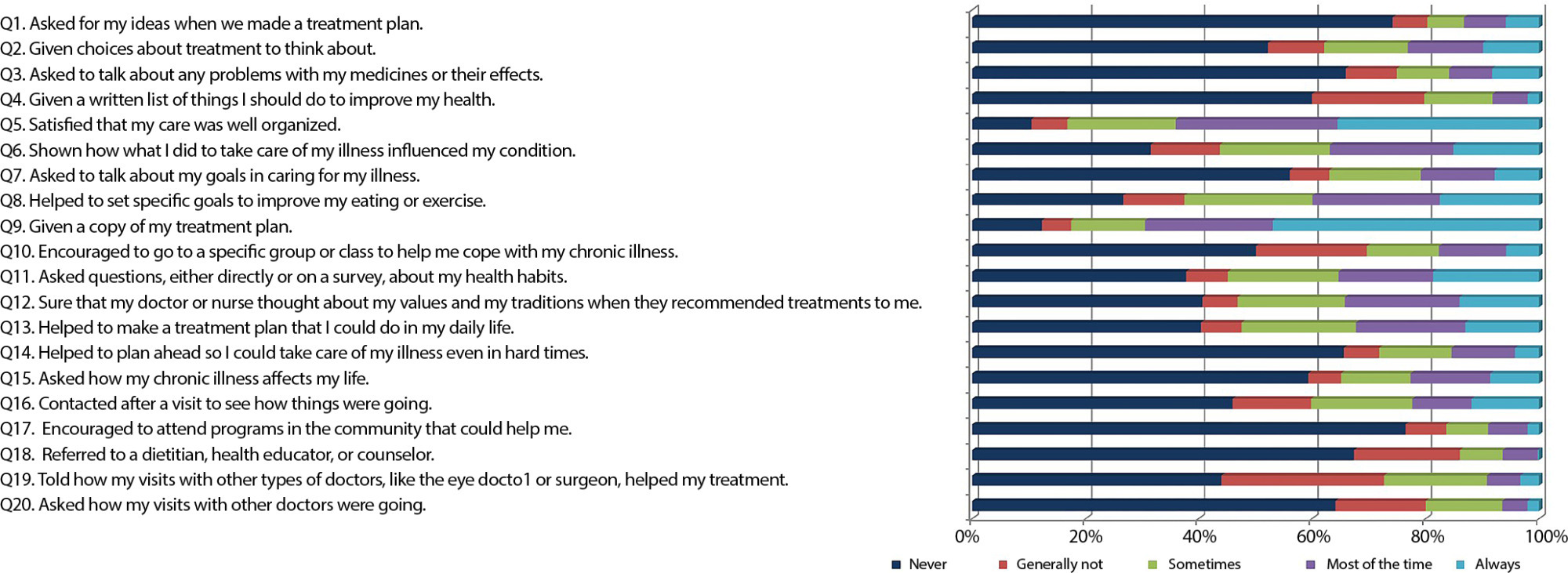
-
ARTÍCULO ORIGINAL24/06/2020
Interprofessional relationships of a patient assistance team in critical care
Revista Brasileira de Enfermagem. 2020;73(4):e20190420
Resumen
ARTÍCULO ORIGINALInterprofessional relationships of a patient assistance team in critical care
Revista Brasileira de Enfermagem. 2020;73(4):e20190420
DOI 10.1590/0034-7167-2019-0420
Visualizações0Ver maisABSTRACT
Objectives:
to identify perceptions of teamwork according to the professionals of an Adult Intensive Care Unit.
Methods:
descriptive research with qualitative approach. The methodological framework was thematic content analysis. The theoretical framework of the work process was used to guide the interpretation of the data. Data collection: A semi-structured interview was conducted with 38 professionals in a public teaching hospital in the state of Minas Gerais. Results: three thematic categories emerged from the interviews: Work Organization, which is related to work performed through tasks/routines, with or without coordinated actions; Non-material Work Instruments, which reveal that teamwork is based on communication/collaboration; Insufficient Material Resources, which indicate that lack of material creates conflicts between professionals.
Conclusions:
Teamwork requires effective communication and collaboration, integrated work and appropriate professional training. On the other hand, fragmentation and rigidity at work, poor collaboration/communication and lack of material make teamwork difficult. We emphasize the need to revise the curriculum of health courses, with a view to including and/or improving discussions about teamwork in order to train professionals for a more integrated and perhaps even sympathetic health practice.
-
ARTÍCULO ORIGINAL01/07/2020
Conhecimento de profissionais da atenção primária em saúde sobre política de saúde para populações ribeirinhas
Revista Brasileira de Enfermagem. 2020;73(5):e20190080
Resumen
ARTÍCULO ORIGINALConhecimento de profissionais da atenção primária em saúde sobre política de saúde para populações ribeirinhas
Revista Brasileira de Enfermagem. 2020;73(5):e20190080
DOI 10.1590/0034-7167-2019-0080
Visualizações0RESUMO
Objetivos:
analisar conhecimentos dos profissionais de saúde sobre a política de saúde para a população ribeirinha; analisar o desenvolvimento das práticas de saúde direcionadas a esse grupo e discutir facilidades e dificuldades de implementar essa política.
Métodos:
estudo qualitativo, descritivo, com 24 profissionais das Equipes de Estratégia Saúde da Família Ribeirinha no município de Belém-Pará. Os dados foram produzidos em entrevista individual e analisados por Análise de Conteúdo.
Resultados:
embora os profissionais conheçam algo da política pública de saúde, há necessidade de ampliar e fortalecer conhecimentos sobre a política de saúde para população ribeirinha. As atividades direcionadas às comunidades ocorriam na própria Unidade, sendo que algumas não eram desenvolvidas por insuficiência de recursos materiais e humanos.
Considerações Finais:
a maior dificuldade para a organização da assistência à saúde é a carência de recursos materiais e humanos, e a maior facilidade é a união e coesão na equipe de saúde.
Palavras-chave: Assistência à SaúdeAtenção Primária em SaúdeEstratégia Saúde da FamíliaPolítica de SaúdePopulações VulneráveisVer mais -
ARTÍCULO ORIGINAL19/08/2019
The daily routine of nurses in rural areas in the Family Health Strategy
Revista Brasileira de Enfermagem. 2019;72(4):918-925
Resumen
ARTÍCULO ORIGINALThe daily routine of nurses in rural areas in the Family Health Strategy
Revista Brasileira de Enfermagem. 2019;72(4):918-925
DOI 10.1590/0034-7167-2018-0243
Visualizações0Ver maisABSTRACT
Objective:
to analyze the daily work of rural Family Health Strategy (FHS) nurses.
Method:
a qualitative, descriptive and exploratory research. The data were collected with eleven rural nurses of the city of Campina Grande, Paraíba State, through semi-structured interviews, between January and March of 2017, using Content Analysis.
Results:
rural nurses have a strong relationship with the population. However, they reveal a daily work with various organizational barriers that range from the team displacement to the workplace to the operationalization of health actions, which are mediated by the characteristics of rurality. Some of these barriers can be remedied by a more proactive action from the management.
Final considerations:
conditioned by the characteristics of rurality, the differentiated dynamics work reveal weaknesses in the quality of nursing care and lower effectiveness of the FHS.
-
ARTÍCULO ORIGINAL06/07/2020
Tempo e qualidade das admissões: carga de trabalho em enfermagem
Revista Brasileira de Enfermagem. 2020;73(5):e20190267
Resumen
ARTÍCULO ORIGINALTempo e qualidade das admissões: carga de trabalho em enfermagem
Revista Brasileira de Enfermagem. 2020;73(5):e20190267
DOI 10.1590/0034-7167-2019-0267
Visualizações0RESUMO
Objetivos:
mensurar o tempo médio despendido pela equipe de enfermagem durante a admissão de pacientes e investigar sua conformidade em relação às atividades descritas pela Classificação das Intervenções de Enfermagem; avaliar o grau de interferência sobre a carga de trabalho da equipe.
Métodos:
observacional com cronometragem de tempo por meio de um software. Acompanharam-se 199 admissões realizadas pela equipe de enfermagem em sete unidades utilizando-se dois instrumentos validados. Escores total ≥ 70% e 50% qualificavam o processo.
Resultados:
o tempo médio dos enfermeiros variou de 5,5 (desvio padrão = 2,3) a 13 (desvio padrão = 1,1) minutos; e dos auxiliares/técnicos, entre 4,7 (desvio padrão = 2,1) e 6,8 (desvio padrão = 2,0) minutos (p ≤ 0,01). Seis admissões realizadas por enfermeiros e 33 por auxiliares/técnicos mostraram-se qualificadas. A intervenção despendeu de 16,3% a 31,5% do tempo da jornada de trabalho da equipe.
Conclusões:
a admissão impacta a carga de trabalho e precisa ser considerada tanto na mensuração das atividades como no dimensionamento da equipe de enfermagem.
Palavras-chave: Avaliação de Processos em Cuidados de SaúdeCarga de TrabalhoFluxo de TrabalhoGerenciamento do TempoRecursos Humanos de EnfermagemVer mais -
ARTÍCULO ORIGINAL18/05/2020
Care of wheelchair pregnant women in the light of Collière’s theory
Revista Brasileira de Enfermagem. 2020;73(4):e20180755
Resumen
ARTÍCULO ORIGINALCare of wheelchair pregnant women in the light of Collière’s theory
Revista Brasileira de Enfermagem. 2020;73(4):e20180755
DOI 10.1590/0034-7167-2018-0755
Visualizações0Ver maisABSTRACT
Objectives:
to discuss care needs of wheelchair pregnant women in the light of Collière’s Theory of Caring.
Methods:
qualitative, descriptive, exploratory, with eight women, between August 2014 and March 2015, in Rio de Janeiro State, Brazil. The method of data collection was the life history. The theoretical reference used was Marie-Françoise Collière’s Theory of Caring. The thematic type analysis identified three categories: pregnancy planning; support and prejudice of family and health professionals; and caring for the wheelchair pregnant woman.
Results:
prejudice, fear, lack of support, lack of knowledge about the maintenance of pregnancy and childbirth interfered negatively in the process of gestation. Participants had urinary tract infection, miscarriages and preterm birth.
Final Considerations:
gestation in these women should predict possible intercurrences, which makes it imperative to train professionals in integral care to promote and protect health.
-
ARTÍCULO ORIGINAL09/04/2020
Trabalho e competência do enfermeiro nos serviços de hemoterapia: uma abordagem ergológica
Revista Brasileira de Enfermagem. 2020;73(3):e20180775
Resumen
ARTÍCULO ORIGINALTrabalho e competência do enfermeiro nos serviços de hemoterapia: uma abordagem ergológica
Revista Brasileira de Enfermagem. 2020;73(3):e20180775
DOI 10.1590/0034-7167-2018-0775
Visualizações1RESUMO
Objetivos:
analisar os ingredientes da competência que os enfermeiros utilizam na realização do seu trabalho na hemoterapia.
Métodos:
estudo qualitativo com 22 enfermeiros, realizado por meio de estudo documental, observação e entrevista semiestruturada, com recursos do software Atlas.ti, embasado nos fundamentos do Materialismo Histórico Dialético e da Ergologia. Foi efetuada Análise de Conteúdo.
Resultados:
o domínio do conhecimento específico da hemoterapia e o tempo de experiência na área, aliados à motivação do trabalhador e à capacidade de trabalho em equipe, favorecem o agir com competência nas atividades laborais. Por outro lado, a falta de condições adequadas de trabalho, especialmente em relação a materiais, equipamentos e estrutura adequados, prejudica o trabalho do enfermeiro em hemoterapia.
Considerações Finais:
a experiência adquirida é determinante para o sucesso na tomada de decisão. Além disso, condições adequadas de trabalho, atualização de conhecimentos e habilidade no trabalho em equipe favorecem um cenário de práticas seguras.
Palavras-chave: Assistência de EnfermagemDoação de SangueServiço de HemoterapiaTrabalhoTransfusão de SangueVer mais -
ARTÍCULO ORIGINAL25/10/2022
Caracterização clínica, incapacidade e mortalidade de pessoas com acidente vascular cerebral isquêmico em 90 dias
Revista Brasileira de Enfermagem. 2022;75(2):e20201383
Resumen
ARTÍCULO ORIGINALCaracterização clínica, incapacidade e mortalidade de pessoas com acidente vascular cerebral isquêmico em 90 dias
Revista Brasileira de Enfermagem. 2022;75(2):e20201383
DOI 10.1590/0034-7167-2020-1383
Visualizações0RESUMO
Objetivos:
descrever características clínicas e a mortalidade de pessoas com acidente vascular cerebral isquêmico; comparar a incapacidade antes do evento e 90 dias depois.
Métodos:
estudolongitudinal, com 308 pessoas hospitalizadas em Salvador-BA. A coleta de dados ocorreu de 03/2019 a 01/2020. Empregou-se estatística descritiva e inferencial.
Resultados:
a média de idade foi de 64,8 anos ( dp=14,1) e a pontuação da National Institute of Health Stroke Scale foi 10,7 (dp=7,2). Amediana do tempo de internação foi de 11 dias. Predominaram negros (84,0%), escolaridade até o fundamental (68,4%), renda até três salários mínimos (89,1%), chegada até 4,5 horas do início dos sintomas (57,9%) e internação em unidade especializada (71,8%). Realizaram trombólise: 26,0%. Predominou a categoria assintomática (85,3%) antes do evento e incapacidade moderada/severa (41,5%) após 90 dias (p= 0.117). Óbito atingiu 19,7% da amostra.
Conclusões:
a alta mortalidade e incapacidade geradas pelo evento têm implicações para a gestão e cuidado em saúde.
Palavras-chave: Acidente Vascular CerebralEnfermagemEpidemiologiaEstatísticas de Sequelas e IncapacidadePrevenção de DoençasVer mais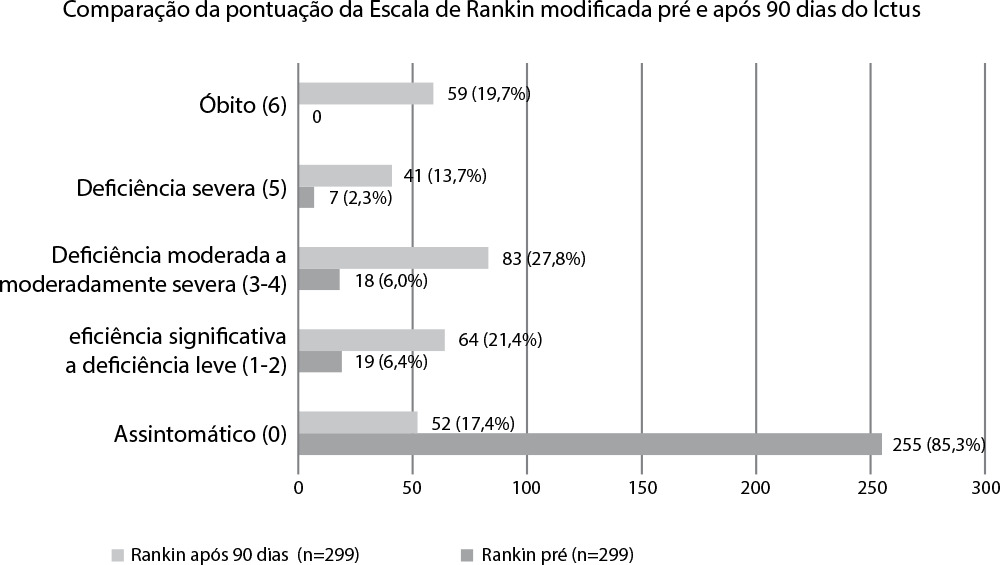
-
ARTÍCULO DE REVISIÓN13/07/2020
Augmentative and Alternative Communication in Ventilated Patients: A Scoping Review
Revista Brasileira de Enfermagem. 2020;73(5):e20190562
Resumen
ARTÍCULO DE REVISIÓNAugmentative and Alternative Communication in Ventilated Patients: A Scoping Review
Revista Brasileira de Enfermagem. 2020;73(5):e20190562
DOI 10.1590/0034-7167-2019-0562
Visualizações0Ver maisABSTRACT
Objectives:
to map the benefits of Augmentative and Alternative Communication in ventilated adults in Intensive Care Unit and identify strategies used.
Methods:
a Scoping Review was carried out according to the Joanna Brigs Institute Protocol. The research question was: “In adult patients ventilated in Intensive Care Units, what are the benefits of Augmentative and Alternative Communication?”. An article research was carried out at PubMed, EBSCOhost and B-On databases. It was held between October and November 2018, from 2013 to 2018, in Portuguese and in English.
Results:
61 references were obtained. After selection according to the inclusion criteria, 7 articles were analyzed.
Conclusions:
studies enunciate Augmentative and Alternative Communication as a strategy to enhance communication, describing methods and tools. There is no agreement on the most effective tool.
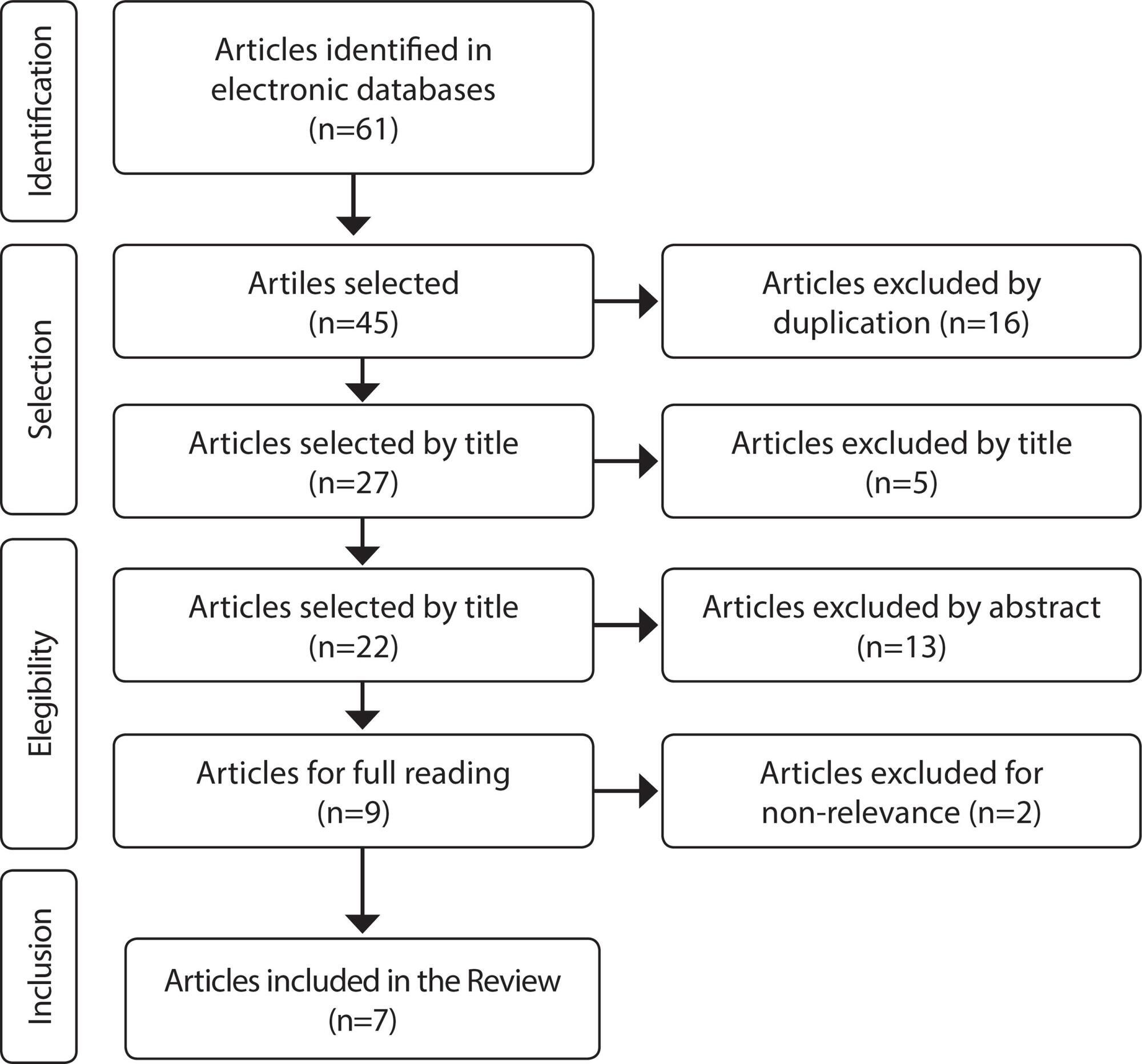
Búsqueda
Buscar en:
Nuvem de Tags
Adolescente (85) Atenção Primária à Saúde (239) COVID-19 (91) Criança (91) Cuidados de Enfermagem (269) Educação em Enfermagem (151) Educação em Saúde (139) Enfermagem (930) Enfermagem Pediátrica (86) Estudantes de Enfermagem (77) Estudos de Validação (131) Família (87) Idoso (208) Promoção da Saúde (99) Qualidade de Vida (104) Saúde do Trabalhador (86) Saúde Mental (145) Saúde Pública (82) Segurança do Paciente (150) Tecnologia Educacional (100)



